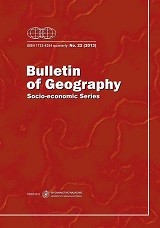Cartographic source materials and cartographic method of research in the past environment analyses
Cartographic source materials and cartographic method of research in the past environment analyses
Author(s): Kamil Nieścioruk Subject(s): Essay|Book Review |Scientific Life
Published by: Wydawnictwo Naukowe Uniwersytetu Mikołaja Kopernika
Keywords: GIS; early maps; landscape analyses; cartography; environment changes
Summary/Abstract: The article reviews a methodology of using early maps and other cartographic materials in the past environment studies. The application of the cartographic method of research is presented on examples from different research fields, but cases from the Earth Science are analysed deeper - from hydrography, through geomorphology to many aspects of economic geography. What is broadly described is a detection of human interaction with the nature: all traces that are marked by settlement, land use, communication, etc. This paper shows that the past environment, with its ways of use and topology can be recreated using early maps. These materials help finding hidden marks from the past, saved in abandoned orchards, old roads composed into modern network, toponyms storing past spatial relations, etc. It is also shown that analyses of early maps have to be conveyed with great care and responsibility, especially when it comes to geometric properties of old cartographic materials. The Geographic Information System (GIS) is helpful in such a situation, but its use is more profound. In this paper GIS is described as a tool being a great step forward in the applications of cartographic method of research and many examples of such applications in the field of a landscape analyses are given - from simple yet informative numeric outcomes of research to 3D virtual creations of long-gone landscapes
Journal: Bulletin of Geography. Socio-economic Series
- Issue Year: 2013
- Issue No: 22
- Page Range: 81-95
- Page Count: 15
- Language: English

